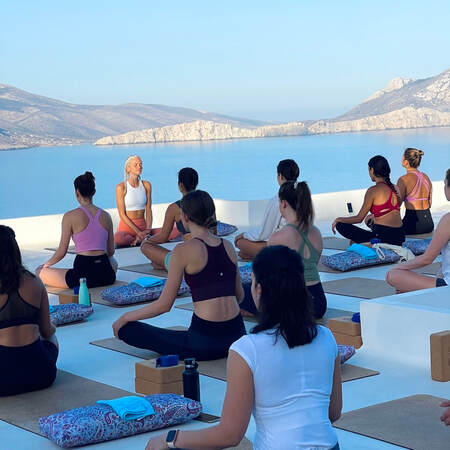Information


Taking the Yoga Philosophy on the mat – How can we apply the Yamas in our asana practice…
The Yoga philosophy of Patanjali (Raja yoga) provides us with 8 clear steps towards enlightenment or freedom/Moksha. These 8 limbs of yoga (yamas, nyamas, asana, pranayama, pratyahara, dharana, dhyana, samadhi) are the pillars of Raja yoga and can be practiced by anybody who follows this yoga path of self-discipline and will power. The first limb is the “Yamas” which are the social conducts and how to behave in the world. There are 5 Yamas mentioned by sage Patanjali which I will attempt to explain below in my understanding. Although they were created for external use in the social life, it is important to practice these everywhere, on and off the mat. When we understand the meaning and application of each one in practical sense in our yoga asana practice, this might help us do so in our social environment also. Below I will relate these to the asana practice and how we can apply the Yamas on the mat to the best of my knowledge and personal experience both as a student and as a teacher.
Ahimsa presents us the concept of no harm or non-violence in our thoughts, speech and actions. Often times, ego can get involved in our practice and we can start to compete with ourselves or others. This can impede our development on the mat, cause distraction and maybe even injury. We can apply the concept of ahimsa by inviting kind thoughts in our practice without any judgement of the body or the level of our asana practice. Should thoughts that are judgemental or negative come through, we can learn to pause and observe these, taking Balasana (child’s pose) to regroup and as a reminder of the purpose of the asanas. We can apply ahimsa by not forcing ourselves into an asana or pushing our body to reach a posture when it is not ready. This is not a safe approach for the physical self and also for the mind. Instead, we can learn to appreciate the current state of the body and learn to accept this. The body is always changing, one day we can feel strong, and another, we can step on the mat feeling completely out of balance. Neither are wrong, weak or in need of judgement, they are just different. Practice with compassion, self-acceptance and non-harm.
Satya is the second of the Yamas and it refers to being truthful. This is an important aspect of our yoga practice on and off the mat. We must always be truthful in our practice with no ulterior motives, without the need to be admired for our abilities or in denial of our current physical state. Practice in truth and remind yourself why you step on your mat when you do. Setting a Sankalpa (intention) at the beginning of the practice can help to keep the focus when these distractions occur. If an asana is not accessible for you in that moment, let it go. Do it to the best of your abilities and be truthful to where you are at currently. Most importantly, stay truthful to your practice and do it with integrity. The intention of our practice has more significance than how “advanced” we do each asana.
I can relate the concept of asteya on the mat with looking around at other’s mats and trying to copy what they are doing or trying to do it better than they do it. Our focus should always be on our own practice. Every physical body is different and every person has their own journey on the mat. Stay truthful to yours, focus on your own practice and try not to take other’s practice and apply it as your own. Instead, apply the teachings from your yoga teacher to best support your asana journey and let it unfold naturally.
Although Brahmacharia refers to celibacy, its meaning can also be also be associated with self-discipline and learning not to lust or be in constant desire. Exhausting our energy will also affect our asana practice. Learning the self-discipline of brahmacharia off the mat can help us to integrate the concept of will-power in our practice.
The last of the Yamas is Aparigraha, which can be known as non-possessiveness. The philosophy teaches us to be humble and steady, balanced and centred. When we attach ourselves to our practice this can lead to suffering. No form of attachment leads to a peaceful mind according to Yoga. So every time we step on the mat we can do so from a new perspective, without any possessiveness for the practice or labelling it. I also relate Aparigraha to not claim ownership even of a space of practice or a specific mat. Our asana practice can be done anywhere, so long as there is a clean, well aired and safe environment space.